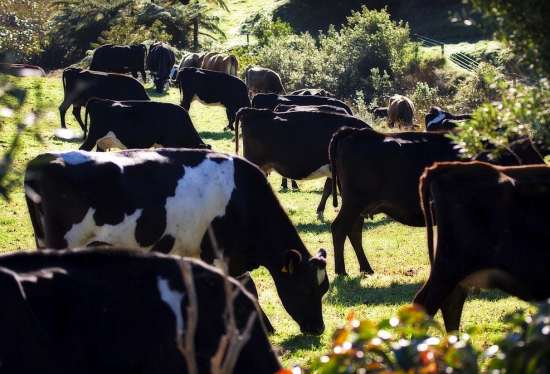Using Compensatory Gain
to Reduce Cattle Feeding Costs

Image Credit: Dave Young
Compensatory gain is an important cattle feeding strategy that grass-fed producers use to reduce their production costs, keep their cattle grazing longer outside of the growing season. and increase cattle weight gains during the pasture growing season.
Compensatory gain is so powerful that it even allows cattle that did not gain weight over the winter to catch up the following spring to cattle that maintained high weight gains throughout the winter on expensive cattle feed rations. And it allows you to produce grass finished beef on pasture at a much lower cost-per-pound-of-gain than traditional cattle feeding programs.
Compensatory gain is the rapid cattle weight gain that cattle experience after a period of body fat loss, such as during the winter grazing season. This rapid cattle weight gain is caused because the cattle's metabolisms take a while to speed up again, during which time the cattle can gain weight with incredible efficiency. This article is going to teach you all about compensatory gain and how to harness it in your grazing herd to reduce your beef production costs.
Creating the right conditions for compensatory gains
First a little background...
Pasture is always MUCH cheaper than feeding cattle with hay, silage, or any other cattle feed rations, as I discussed in the article about the grass-fed solution to high cattle feeding costs. That's why it makes sense to keep the cattle on pasture as long as possible.
Your cattle's fat reserves are the perfect 'free' supplement that allows your cattle to extend their grazing season deeper into the winter, as I explain in the article about preparing your cattle for winter grazing. Fat is the way that your cattle can store the cheap summer grass to supplement their winter nutrition and reduce your overall cattle feeding costs.
By the start of the next growing season your winter grazing cattle, which supplemented themselves using their fat reserves, obviously won't be as heavy as their peers who were wintered on full cattle feed rations for the duration of the winter.
But compensatory gain allows them to catch up to their peers. By the end of the growing season, your winter grazed cattle will be just as heavy, but at a much lower cost per pound of gain, as the cattle kept fattened all winter on expensive feed like hay, silage, or mixed feed rations.
The metabolism - the gas peddle and the brakes of your cattle weight gains
During the winter, while your cattle are slowly tapping into their body fat reserves, their metabolisms slow down considerably. This is a natural survival mechanism which occurs in all animals when the calories available from the food are less than the calories required each day to meet all of the cattle's needs. When the balance tips towards weight loss, the body naturally makes up the difference by tapping into its body fat reserves, which triggers the metabolism to slow down to conserve energy.
However, when the calories go up again, such as when the cattle are turned out onto lush pasture in the spring, the metabolism doesn't bounce back immediately. There is a delayed response. It takes weeks for the metabolism to speed up. This delayed response is an equally important survival mechanism so that a single good day's grazing in the middle of a long drought doesn't erroneously boost the cattle's metabolism.
Using compensatory gain to reduce your cattle feeding costs
This delayed metabolic response allows cattle to gain weight extremely efficiently when they get access to more calorie-rich food, such as during those first few weeks back on growing pasture.
These cattle weight gains are MUCH more efficient than the weight gains among cattle which did not go through a period of weight loss. It allows cattle that experienced a reduction in their body fat reserves to catch up to those that did not, allowing them to compensate for a period of feed shortages. That's why it's called compensatory gain.
Anyone who diets in order to lose weight has first-hand experience with this change in metabolism, which is why dieters often gain a considerable amount of weight, sometimes even more than they lost, in the weeks or months following the end of a diet. So, while compensatory gain may be a frustrating challenge to human dieters trying to lose weight, it is a beneficial and powerful tool that grass-fed producers can use to reduce their cattle feeding requirements during the winter and then gain back all that lost weight very quickly (and very cheaply) as soon as the pastures green up in the spring.
Compensatory gain is a free and very powerful tool to help grass-fed beef producers reduce their production costs. Now that you understand how it works you simply need to learn how to safely use compensatory gain to reduce your overall production costs. What this means is:
- learn to how to monitor your cattle's body condition so that the reduction in their overall body fat reserves during the winter grazing season always stays within safe levels,
- work with a livestock nutritionist to supplement your cattle with the right mineral, protein and energy requirements to keep the changes in your cattle's body condition within safe limits while meeting all your cattle's vital nutritional needs.
To learn more about how to use compensatory gain in your cattle herd to reduce your cost of beef production, I recommend that you read "The Cattle Year on Grass" and the "Market Options" chapters in Grass-fed Cattle.
Related Articles:
(Disclosure: I get commissions for purchases made using Amazon links in my post.) And when you're ready to start planning your cattle farm, check out my book: Grass-Fed Cattle: How to Produce and Market Natural Beef. Use the links below to explore my book and read reviews on Amazon: 
|



